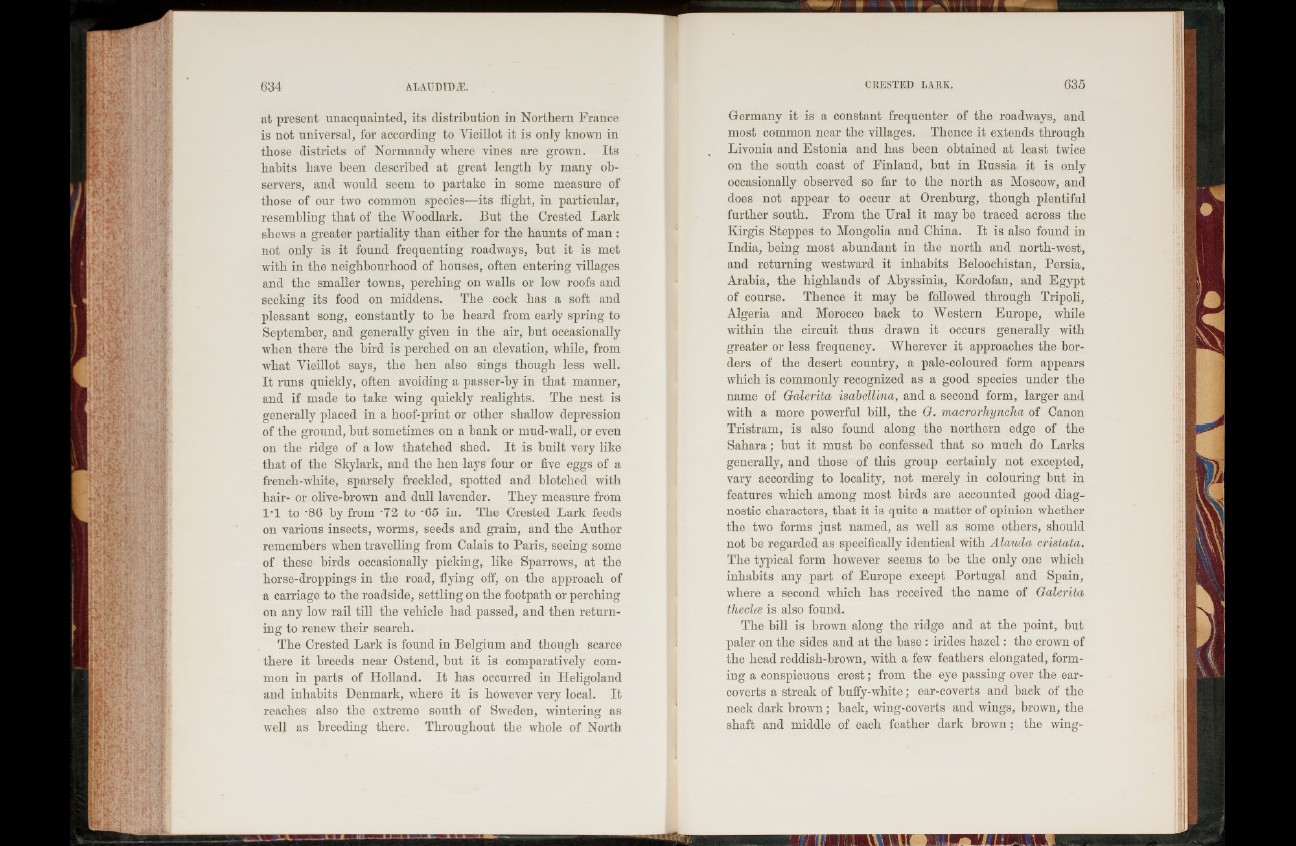
at present unacquainted, its distribution in Northern France
is not universal, for according to Yieillot it is only known in
those districts of Normandy where vines are grown. Its
habits have been described at great length by many observers,
and would seem to partake in some measure of
those of our two common species-—its flight, in particular,
resembling that of the Woodlark. But the Crested Lark
shews a greater partiality than either for the haunts of man :
not only is it found frequenting roadways, but it is met
with in the neighbourhood of houses, often entering villages
and the smaller towns, perching on walls or low roofs and
seeking its food on middens. The cock has a soft and
pleasant song, constantly to be heard from early spring to
September, and generally given in the air, but occasionally
when there the bird is perched on an elevation, while, from
what Vieillot says, the hen also sings though less well.
It runs quickly, often avoiding a passer-by in that manner,
and if made to take wing quickly realights. The nest is
generally placed in a hoof-print or other shallow depression
of the ground, but sometimes on a bank or mud-wall, or even
on the ridge of a low thatched shed. I t is built very like
that of the Skylark, and the hen lays four or five eggs of a
french-white, sparsely freckled, spotted and blotched with
hair- or olive-brown and dull lavender. They measure from
l ' l to ‘86 by from ’72 to -65 in. The Crested Lark feeds
on various insects, worms, seeds and grain, and the Author
remembers when travelling from Calais to Paris, seeing some
of these birds occasionally picking, like Sparrows, at the
liorse-droppings in the road, flying off, on the approach of
a carriage to the roadside, settling on the footpath or perching
on any low rail till the vehicle had passed, and then returning
to renew their search.
The Crested Lark is found in Belgium and though scarce
there it breeds near Ostend, but it is comparatively common
in parts of Holland. I t has occurred in Heligoland
and inhabits Denmark, where it is however very local. I t
reaches also the extreme south of Sweden, wintering as
well as breeding there. Throughout the whole of North
Germany it is a constant frequenter of the roadways, and
most common near the villages. Thence it extends through
Livonia and Estonia and has been obtained at least twice
on the south coast of Finland, but in Russia it is only
occasionally observed so far to the north as Moscow, and
does not appear to occur at Orenburg, though plentiful
further south. From the Ural it may be traced across the
Kirgis Steppes to Mongolia and China. I t is also found in
India, being most abundant in the north and north-west,
and returning westward it inhabits Beloochistan, Persia,
Arabia, the highlands of Abyssinia, Kordofan, and Egypt
of course. Thence it may be followed through Tripoli,
Algeria and Morocco back to Western Europe, while
within the circuit thus drawn it occurs generally with
greater or less frequency. Wherever it approaches the borders
of the desert country, a pale-coloured form appears
which is commonly recognized as a good species under the
name of Galerita isabellina, and a second form, larger and
with a more powerful bill, the G. macrorhynclia of Canon
Tristram, is also found along the northern edge of the
Sahara; but it must be confessed that so much do Larks
generally, and those of this group certainly not excepted,
vary according to locality, not merely in colouring but in
features which among most birds are accounted good diagnostic
characters, that it is quite a matter of opinion whether
the two forms just named, as well as some others, should
not be regarded as specifically identical with Alauda eristata.
The typical form however seems to be the only one which
inhabits any part of Europe except Portugal and Spain,
where a second which has received the name of Galerita
theclce is also found.
The bill is brown along the ridge and at the point, but
paler on the sides and at the base : irides hazel: the crown of
the head reddish-brown, with a few feathers elongated, forming
a conspicuous crest; from the eye passing over the ear-
coverts a streak of huffy-white; ear-coverts and back of the
neck dark brown; back, wing-coverts and wings, brown, the
shaft and middle of each feather dark brown; the wing-
LUftir p n « m i